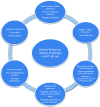Collective patient behaviours derailing ART roll-out in KwaZulu-Natal: perspectives of health care providers
- PMID: 23870285
- PMCID: PMC3765690
- DOI: 10.1186/1742-6405-10-20
Collective patient behaviours derailing ART roll-out in KwaZulu-Natal: perspectives of health care providers
Abstract
Background: Antiretroviral therapy (ART) roll-out is fraught with challenges, many with serious repercussions. We explored and described patient behaviour-related challenges from the perspective of health care providers from non-governmental organisations involved in ART programmes in KwaZulu-Natal, South Africa.
Methods: A descriptive case study design using qualitative approach was applied during this study. Data was collected from nine key informants from the three biggest NGOs involved in ART roll-out using in-depth semi-structured interviews. Transcribing and coding for emergent themes was done by two independent reviewers. Ethical approval for the study was granted by the UNISA research ethics committee of The Faculty of Health Sciences. Written consent was obtained from directors of the three NGOs involved and individual audio taped informed consent was obtained from all study participants prior to data collection.
Results: Findings revealed six broad areas of patient behaviour challenges. These were patient behaviour related to socio-economic situation of patient (skipping of medication due to lack of food, or due to lack of transport fees), belief systems (traditional and religious), stigma (non- disclosure), sexual practices (non-acceptability of condoms, teenage pregnancies), escapism (drug and alcohol abuse) and opportunism (skipping medication in order to access disability grant, teenage pregnancies in order to access child grant).
Conclusion: New programmes need to address patient behaviour as a complex phenomenon requiring a multi-pronged approach that also addresses social norms and institutions. In the face of continued ART scale up, this is further evidence for the need for multi-sectoral collaboration to ensure successful and sustainable ART roll-out.
References
-
- Haacker M. The Impact on the Social Fabric and the Economy. The Macroeconomics of HIV/AIDS International Monetary Fund. 2004.
-
- Oster E. HIV and Sexual Behaviour Change: Why not Africa? NBER Working; 2007a. From: http://www.nber.org/papers/w13049 (accessed 21 July 2013) - PubMed
-
- Tawfik Y, Kinoti S, Blain C. Introducing Antiretroviral Therapy on a large scale. 2002 Hope and Caution: AED. Global Health, Population and Nutrition group. Washington, DC: Academy for Educational Development; 2002.
-
- Venter WDF. What is the optimal CD4 count to start anti retrovirals in HIV infected adults. Southern African Journal of Epidemiology and Infection. 2009;24(4):3.
-
- WHO Country Cooperation Strategy 2008–2013. South Africa: World Health Organisation; From: http://www.who.int/countryfocus/cooperation_strategy/ccs_zaf_en.pdf (accessed 21 July 2013)
Grants and funding
LinkOut - more resources
Full Text Sources
Other Literature Sources


